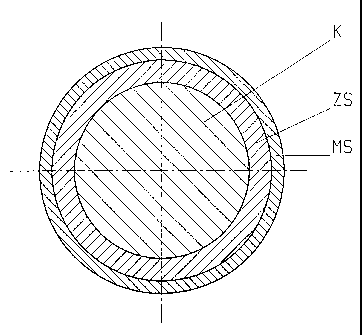Some of the information on this Web page has been provided by external sources. The Government of Canada is not responsible for the accuracy, reliability or currency of the information supplied by external sources. Users wishing to rely upon this information should consult directly with the source of the information. Content provided by external sources is not subject to official languages, privacy and accessibility requirements.
Any discrepancies in the text and image of the Claims and Abstract are due to differing posting times. Text of the Claims and Abstract are posted:
| (12) Patent: | (11) CA 2264902 |
|---|---|
| (54) English Title: | HIGH-STRENGTH EROSION ELECTRODE |
| (54) French Title: | ELECTRODE D'EROSION DE FORTE INTENSITE |
| Status: | Expired and beyond the Period of Reversal |
| (51) International Patent Classification (IPC): |
|
|---|---|
| (72) Inventors : |
|
| (73) Owners : |
|
| (71) Applicants : |
|
| (74) Agent: | SMART & BIGGAR LP |
| (74) Associate agent: | |
| (45) Issued: | 2005-08-09 |
| (86) PCT Filing Date: | 1997-08-22 |
| (87) Open to Public Inspection: | 1998-03-12 |
| Examination requested: | 2002-04-16 |
| Availability of licence: | N/A |
| Dedicated to the Public: | N/A |
| (25) Language of filing: | English |
| Patent Cooperation Treaty (PCT): | Yes |
|---|---|
| (86) PCT Filing Number: | PCT/EP1997/004595 |
| (87) International Publication Number: | WO 1998009764 |
| (85) National Entry: | 1999-03-03 |
| (30) Application Priority Data: | ||||||
|---|---|---|---|---|---|---|
|
The invention concerns a high-strength erosion
electrode having good electrical conductivity. Said
erosion electrode comprises a steel core, an intermediate
layer of copper or a copper-containing alloy, and an
outer layer containing at least 40 % zinc. The steel
core comprises a patented structure which contains
between 0.6 and 1 wt.% carbon and occupies an area of the
core corresponding to between 5o and 75 % of the erosion
electrode diameter, the intermediate layer occupying an
area of between 5 and 40 % of the total diameter, the
outer layer occupying an area of between 10 and 30 %, and
the zinc content of the outer layer being between 40 and
60 wt.%.
L'invention concerne une électrode d'érosion de forte intensité présentant une bonne conductivité électrique. Cette électrode comprend une partie centrale en acier, une couche intermédiaire en cuivre ou en alliage contenant du cuivre, et une couche extérieure contenant au moins 40 % de zinc. La partie centrale en acier comprend une structure brevetée présentant une teneur en carbone qui est comprise entre 0,6 et 1 % en poids et occupe une zone de la partie centrale représentant entre 50 et 75 % du diamètre de l'électrode. La couche intermédiaire occupe une zone représentant entre 5 et 40 % du diamètre total, la couche extérieure occupe une zone représentant entre 10 et 30 %, et la teneur en zinc de la couche extérieure est comprise entre 40 et 60 % en poids.
Note: Claims are shown in the official language in which they were submitted.
Note: Descriptions are shown in the official language in which they were submitted.

2024-08-01:As part of the Next Generation Patents (NGP) transition, the Canadian Patents Database (CPD) now contains a more detailed Event History, which replicates the Event Log of our new back-office solution.
Please note that "Inactive:" events refers to events no longer in use in our new back-office solution.
For a clearer understanding of the status of the application/patent presented on this page, the site Disclaimer , as well as the definitions for Patent , Event History , Maintenance Fee and Payment History should be consulted.
| Description | Date |
|---|---|
| Time Limit for Reversal Expired | 2015-08-24 |
| Letter Sent | 2014-08-22 |
| Grant by Issuance | 2005-08-09 |
| Inactive: Cover page published | 2005-08-08 |
| Inactive: Final fee received | 2005-05-27 |
| Pre-grant | 2005-05-27 |
| Notice of Allowance is Issued | 2004-12-10 |
| Letter Sent | 2004-12-10 |
| Notice of Allowance is Issued | 2004-12-10 |
| Inactive: Approved for allowance (AFA) | 2004-12-01 |
| Amendment Received - Voluntary Amendment | 2004-10-29 |
| Inactive: S.30(2) Rules - Examiner requisition | 2004-04-29 |
| Amendment Received - Voluntary Amendment | 2004-03-19 |
| Inactive: S.30(2) Rules - Examiner requisition | 2003-09-23 |
| Amendment Received - Voluntary Amendment | 2002-06-07 |
| Letter Sent | 2002-05-29 |
| Request for Examination Requirements Determined Compliant | 2002-04-16 |
| All Requirements for Examination Determined Compliant | 2002-04-16 |
| Request for Examination Received | 2002-04-16 |
| Inactive: Cover page published | 1999-05-18 |
| Inactive: IPC assigned | 1999-04-28 |
| Inactive: First IPC assigned | 1999-04-28 |
| Inactive: Notice - National entry - No RFE | 1999-04-13 |
| Application Received - PCT | 1999-04-12 |
| Application Published (Open to Public Inspection) | 1998-03-12 |
There is no abandonment history.
The last payment was received on 2004-07-12
Note : If the full payment has not been received on or before the date indicated, a further fee may be required which may be one of the following
Please refer to the CIPO Patent Fees web page to see all current fee amounts.
Note: Records showing the ownership history in alphabetical order.
| Current Owners on Record |
|---|
| BERKENHOFF GMBH |
| Past Owners on Record |
|---|
| BERND BARTHEL |
| HANS HERMANNI |
| HEINRICH GROOS |
| KLAUS TAUBER |